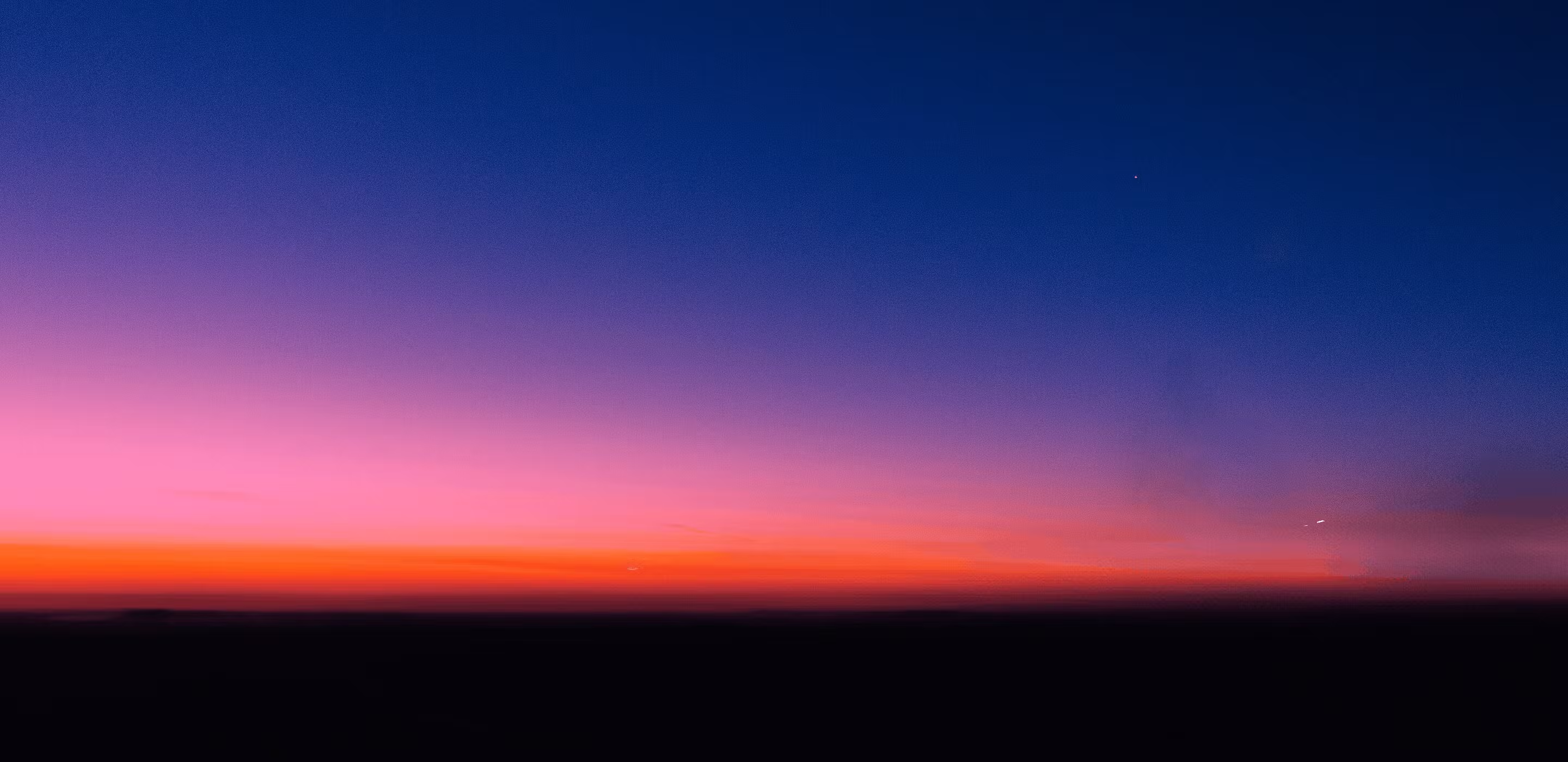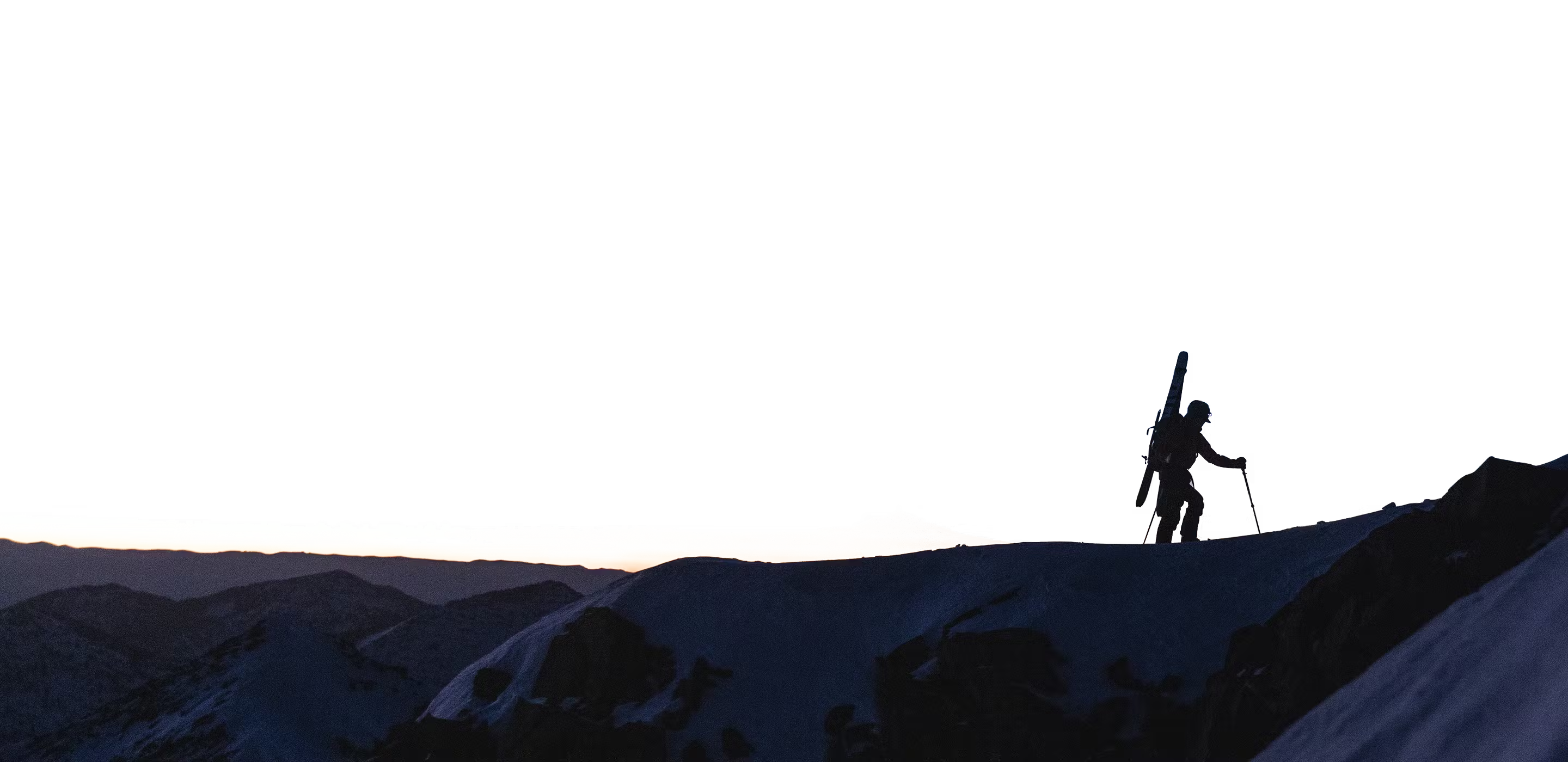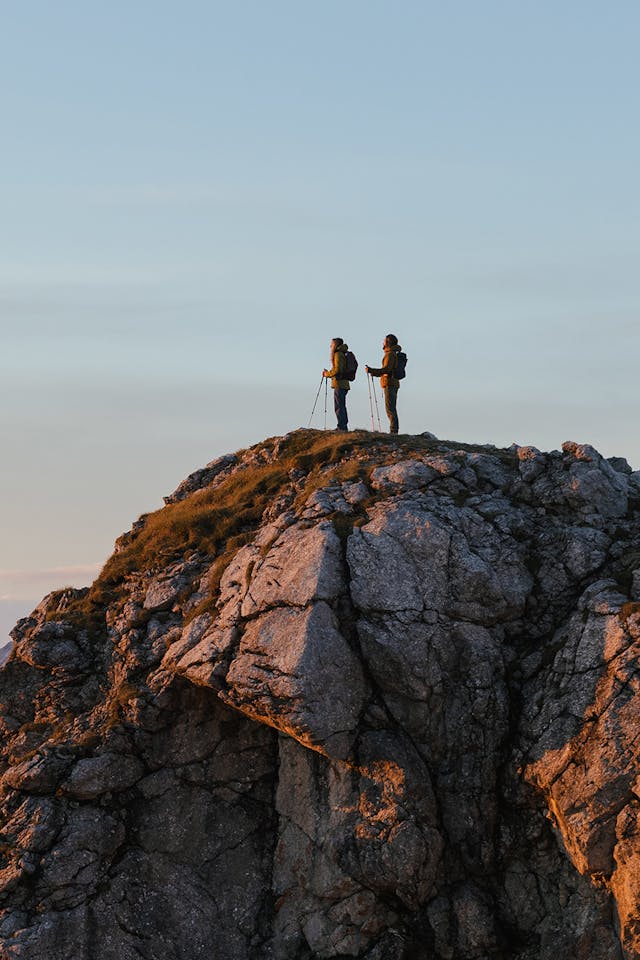On April 5, 2018, two friends and I were involved in an avalanche incident on Sentinel Pass near Mt Temple in Alberta, Canada. The event has opened my eyes and seemingly the eyes of others into some takeaways that we as winter backcountry travelers can learn from. I’m discussing this because I feel there might be a lesson or a point from this slide that could help someone in the future. Not only is it a compelling story with a very fortunate and happy ending—we pulled off what sounds like one of the deepest companion rescues that most people have heard of—but there are some lessons too. In hindsight, there are things we could have done been better.
Just for some background leading up to the avalanche … Most of the winter I was focusing on photographing ice climbing and rock climbing, and not focusing on what was happening in the Canadian Rockies snowpack. The day the avalanche happened was my first ski day of the year. I hadn’t looked at an avalanche forecast in-depth for at least a month and I hadn’t decided to go skiing that day until about 15 minutes before we left. I was supposed to be shooting the ice climb Nemesis, at the Stanley Headwall but decided at the last minute that it would probably be more fun to go skiing than to sit in the snow and take pictures of other people having fun.
Little did I know what was coming …
With only 15 minutes to get ready I unpacked my climbing gear, repacked my ski gear, checked the avalanche bulletin quickly, grabbed a coffee and jumped in the car with my friends.
Here’s what snow safety gear I packed:
- PIEPS DSP Pro Avalanche Beacon (now redesigned as the PIEPS Pro BT)
- Black Diamond Quickdraw Carbon Probe 240cm
- Black Diamond Deploy 3 Shovel
- Black Diamond Bandit AvaLung Pack
WHERE WERE WE SKIING?
The tour we were going on that day was more a mission to look at climbing options in the area vs a day out getting turns. We skied roughly 12km (7.5 miles) up Moraine Lake road and had a quick snack before starting up the summer hiking trail for Larch Valley.
The Larch Valley trail to the top of Sentinel Pass is an additional 6.8km (4.25 miles) with 735m (2425ft) elevation gain. We were just approaching the top of the pass when I looked down and saw a shooting crack emanate from my ski. I thought, that’s a bad sign, maybe we shouldn’t be here and turned around to talk to my partners about possibly turning around. That’s when I saw we were all caught in the avalanche and realised that a large portion of the slope we were on had fractured, for as far as I could see at the time, approximately 200-225m (650ft-750ft) wide.
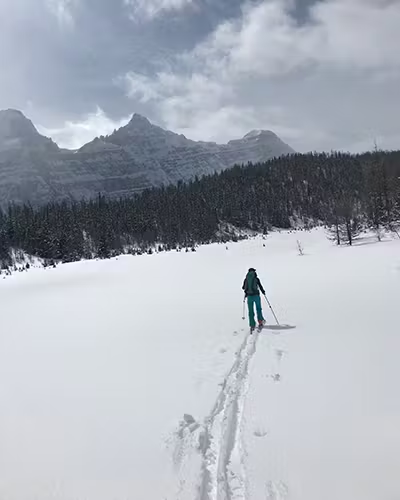
WHAT HAPPENED?
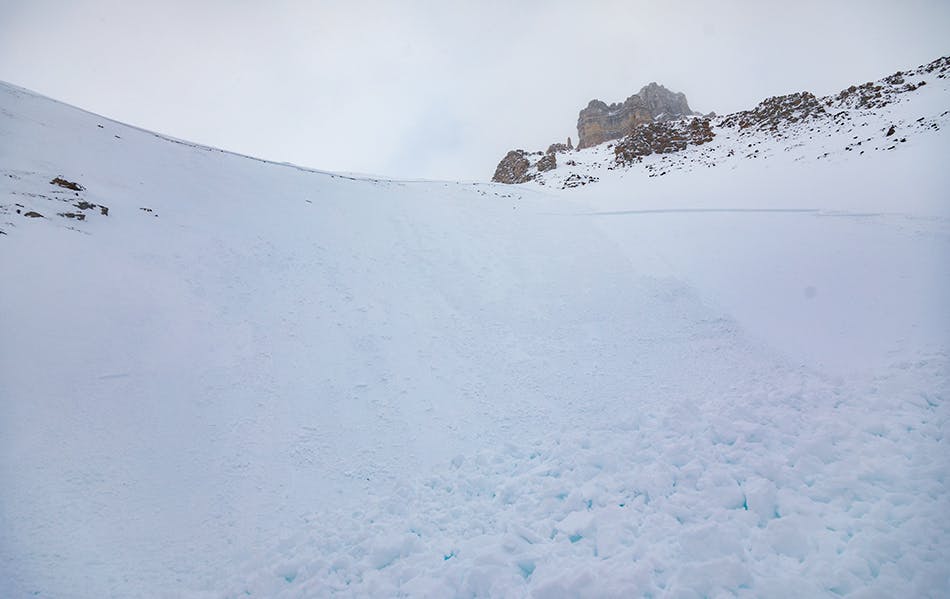
I initially tried to self-arrest, being close to the crown of the avalanche, and thought I had a chance of stopping myself or at least staying on top of the debris by slowing myself enough that the bulk of the snow would go downhill faster than me, leaving me on top.
As soon as I realized I was likely going to stop or at least be on top of the snow I started looking for my partners. The closest partner was still on top of the snow and I watched her ride the snow down almost like she was sitting in a chair. I hadn’t seen her initial struggle while also trying to self-arrest, but watched the slide carry her approximately halfway down the slope. I immediately noticed our third partner, who was around 100ft behind us, was already buried and I hoped to see some part of her re-surface so I could get a reference point while the snow was moving. Unfortunately,I didn’t see anything. I was trying to track both of them simultaneously, but I had a good idea of where the partner who was above the snow was and where she would likely end up if she did get buried. The other buried partner was more of a concern, so I paid closer attention to where I thought she was in the snow and where that mass of snow stopped. The crown spread across two aspects and the way the two slopes funneled together, along with how the slope angle changes abruptly at the bottom of the pass created a large wave that rose up like an ocean swell. It looked like she was probably underneath it. It was clear that it was a deep burial from the start, but I never expected it to be ~4m (13ft).
I wrote a more in-depth trip report about the experience in the local Canadian Rockies backcountry ski Facebook group and it was reposted by Gripped here.
Paul Clarke from the Rocky Mountain Outlook, Canmore’s newspaper, also wrote about it here.
Was she under the wave?
In a quick summary, I fell from where I had self-arrested approximately 200 meters down the icy layer the avalanche slid on and ended up very close to the partner who was partially buried. We quickly checked ourselves to make sure we were ok, turned our beacons to receive and immediately headed in the direction where the wave of snow had formed. The partially buried partner was ok but still stuck in the snow buried from the legs down. However, she could get herself out so I left her and started the search.
My beacon quickly went from 35m to 20m to 12m when I heard my partner say that she had a reading closer to 9m. I immediately headed toward her and the distance on my screen started to decrease, 8m then 6m and then 4m but after that the numbers started going up again. The distance went back up to 5m and then to 6m. I backtracked, reversing back to the smallest reading and checked the other directions—the numbers all increased again, and 4m was the smallest number we saw. It seemed like she was vertically 4m below us. We were both in shock.
I had taken two AST-1 courses previously, but they were in 2004 and 2006. I don’t remember much of the details from them, but I certainly didn’t remember them covering what to do if your partner is buried deeper than the length of your probe. One thing I found, however, was the ease at which a new beacon helped me to locate the buried skier. On those avalanche courses I had taken previously I had an old analog beacon and I do remember listening to beeps and the whole process of finding a buried skier being time-consuming and not straightforward in training.
Approximately a year ago, I updated my avalanche beacon, primarily because I spend a lot of time in avalanche terrain for fun and work. It felt right to get a new beacon, as having a beacon from 2004 didn’t seem fair to either the people who cared about me or to my partners anymore. The second reason I had upgraded my beacon was because I wanted to be able to use the TX 600 which would allow me to have a secondary beacon for Trango, my dog, that I could search for on a different frequency (456hz) than traditional beacons at 457hz. I didn’t really research new beacons that much, I just knew I wanted something with three antennas and the ability to switch to a different frequency so that I could use the TX 600 transmitter as well, which limited me to the PIEPS DSP pro(redesigned as the PIEPS Pro BT).
It’s 4m deep what do we do?
Our memories from this part of the rescue are a bit blurred. There are moments when I don’t remember who did what, but I do remember sitting there going “F&*k she’s buried 4m … we’re f*&ked”. Fortunately, my partner had a longer probe, closer to 3m, but still our beacons were showing 4m. We quickly got our shovels and probes out, put them together and did a quick probing search. We didn’t get a strike and hadn’t expected to either, so we began the process of figuring out what to do.
The 4m reading wasn’t from standing, it was when the beacon was placed directly on the snow when we were trying to pinpoint where the buried skier was located. I quickly dug down a shovel depth and put the beacon on the snow again and it read 3.8m. I’ve been taught to test and then re-test, so I did it again, dug down another shovel depth and put the beacon on the ground, and it read 3.6m. From that, we summarized we were headed in the right direction and decided to start digging.
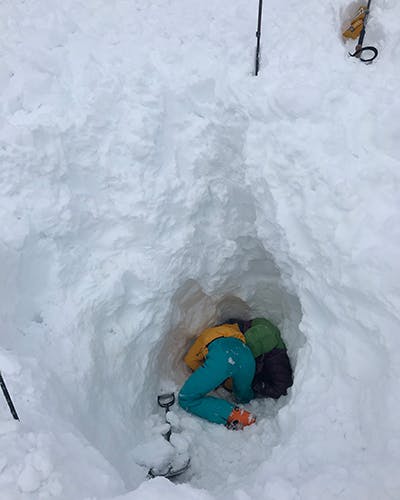
We knew we needed an effective area to probe so we dug down approximately a meter and created a probable area that was approximately one meter wide and 2 meters long. We didn’t do this intentionally, I think it was more instinct and logic at the time. It seemed like the right size to be able to find someone.
We probed again, and I got a strike after several attempts. It was so deep that I thought it was the ground or a boulder. I had been told previously that a probe strike would feel mushy, like a person or a coat, but that wasn’t the case. It was hard. Had we found our friend or the ground? (Turns out I had hit the upper part of her pack, I think the pack and a Tupperware case may have been what I hit making it seem more rigid then I expected).
So, we dug and dug and dug at max pace during the first 20 minutes. I had a heart rate monitor on so it’s interesting to see that graph, basically 90%+ max heart rate during those initial moments. The whole time I was cursing my small shovel … I had the smallest BD shovel at the time when I purchased it, and I was mildly upset with myself for cutting weight on one of the most important of essentials—my probe and shovel—vs leaving out an extra camera battery and other camera related stuff. There was nothing I could do about it at the time other than to make do.
How was the buried skier?
When I first saw orange under the snow I was in shock again. We had found her! At the same time, I was dreading what condition she would be in. I had been involved in some other situations where I was the first responder and I wasn’t looking forward to that experience with a close friend. Then she made noise. She was alive! Next, we cleared her airway and got some snow out from around her pack, giving her room for her chest to expand so she could breathe.
We found the inReach in her pack, activated the SOS and dug her out of that hole for maybe another two hours. When digging, we initially made contact with her close to her head but her lower body and skis were still trapped in the snow. They were down another metre and farther away from us. It took longer than I thought it would to dig her out after we had freed her face and shoulder area because she was still attached to her skis. Our primary objective was to get her an airway and then deal with what came next. We knew that it would take a long time for the two of us to free her.
What did I learn?
There are definitely a couple takeaways for me that I will apply to my future adventures in the mountains.
1. Read the forecast in detail. The morning of the avalanche I was rushed and did not pay particularly close attention to the bulletin. I saw Low/Low/Moderate and did not read much further. If you read the forecast from that day in more detail it discusses the possibility of triggering the layer we activated on the same aspect we were skinning up. I’d rather not get into another avalanche in the future.
The Avalanche Forecast the day of the slide:
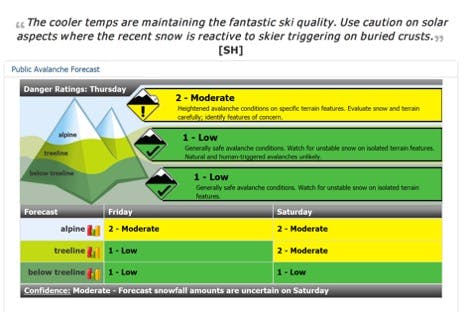
The details from the bulletin the day of the slide:
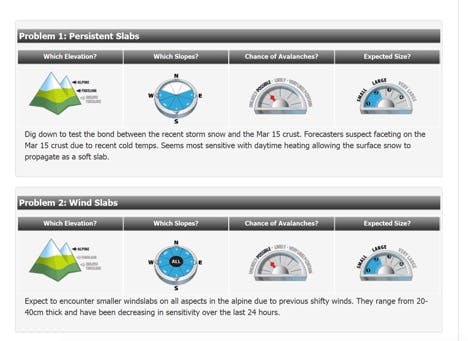
The forecast the following day indicating the details of our avalanche:
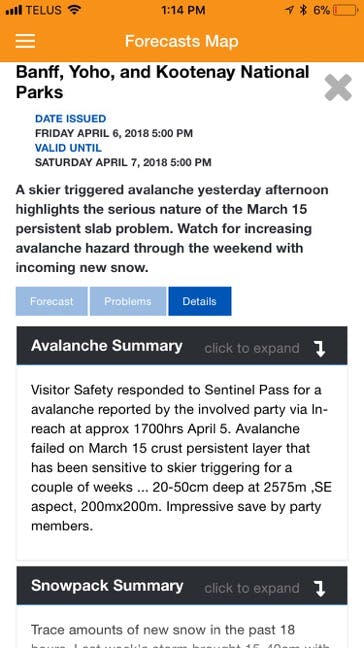
2. Having an understanding of your equipment and how to use it is critical. Fortunately, my new beacon worked exactly like I thought it would—turn it on and follow the arrows—and I can’t imagine what would have happened if it didn’t. I also would have liked to have had familiarity with my friend’s inReach. Being a tech and frequent gadget user, I had thought it would be straightforward to use an inReach, but I was surprised how, under stress, it seemed complicated to use. It’s not, I just couldn’t figure it out, fortunately my partner was smart enough to read the instructions on the backside of the device and initiate the SOS.
3. Previously, I have openly stated that I would never buy a probe longer than 3m because no one will live under 3m anyway. Statistically, that’s a pretty true statement considering survival rates at 2m are only 3%. Two days after our slide I purchased a new 320cm probe. I learned my lesson. Being a photographer, I always have a DSLR, an extra lens and an extra battery or two in my pack but I was skimping weight on the equipment that can save a friend’s life. Next time I won’t carry the extra camera battery and carry the longer probe instead.
4. I’d say the same thing about the shovel. I have a larger shovel, but I tend to take that on trips that are overnight, where I’ll be making snow walls and doing a lot of digging, rather than for day missions. I had a smaller shovel that day to save on weight. I won’t be carrying the small one on similar tours anytime soon. I’ll just try a bit harder and carry a few more grams/ounces of kit. At one point while digging we switched shovels briefly and it was apparent to me that having a larger shovel would have helped in our accident.
5. I’ve become a little more cautious about new partners I head out with and the terrain we are choosing. Many people are meeting their partners online for the first time and I think that’s great! However, I wouldn’t want to be in avalanche terrain with someone I just met online. This is new for me, and I used to be more carefree about who I went into the mountains with, but after having gone through this slide I think I’d prefer having someone I trust searching for me if the scenario was reversed vs someone I met at a coffee shop for the first time that morning.
ANYTHING ELSE?
A couple of Avalanche Associations reached out to me and asked about what I thought the importance was of watching the snow where I thought the buried skier was while the snow was still sliding. I thought this was critical to our timing in finding her, as there wasn’t much screwing around once we started searching and we were within 10m of her in the first minute or two because we had an idea of where she was buried.
In a 2012 study by Pascal Haegeli at Simon Fraser University in Vancouver, Canada, which compares Canadian to Swiss survival rates based on burial times, it was shown that in Canada, as the burial time increases you are significantly less likely to survive an avalanche. That’s expected, and the overall window of survival is closer to 10-18 minutes. To me, this stresses the importance of finding your partner fast and I believe that watching the snow and having newer generation beacons attributed to this.
There were human factors that lead to our incident, and I think fully reading the forecast, including the written details could have changed what happened that day. Certainly, if I see Low/Low/Moderate again I won’t assume that everything is fine and I will read deeper into the avalanche bulletin.
I am considering carrying a second communication device more often in the future too. That might be too much gear for a light and fast alpine route, but for other routes I can see it making sense. I figure that I can carry an extra VHF radio or sat phone for the group, in addition to the inReach that someone else normally has. If we would not have been able to get to the buried skier’s inReach, it would have complicated our day being several hours from the road.
This may not seem apparent, but don’t rush getting to the buried skier and risk getting hurt as the rescuer. Without two rescuers in our scenario, the outcome would have been different. I was able to self-arrest on the icy layer but then fell the length of the slope. Falling probably saved us time getting to the buried skier, but this easily could have gone differently. I have heard of incidents where rescuers are above the crown with buried partners far below at the base of the slope. I think chatting about not taking the additional risk of getting hurt as the rescuer and how an additional injury can create issues in the rescue is warranted; we were lucky.
BOTTOM LINE
Having two fit rescuers and a good understanding of what to do once the snow stopped moving helped when everything went wrong. We were fortunate to pull off such a deep companion rescue. This avalanche will change a few things I do in the mountains going forward.
--Tim Banfield
Featured Gear
